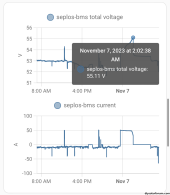I have a Sofar ME3000SP which I’ve so far (no pun intended) used in lithium mode with communication to the Seplos BMS.
I’m trying to use it in general mode (intended for lead-acid batteries) and it has these parameters
Overvoltage protection (V)
Max charge voltage (V)
Low voltage protection (V)
Min discharge (V)
Empty discharged (V)
Full charged (V)
This is what I understand so tell me if I’m right or wrong:
I guess the last 2 are used to estimate the SoC
Max charge voltage is the voltage not to be exceeded during charge; I assume this is first limited by the amount of current the battery can take and as the voltage hits this limit the current is reduce (constant current- constant voltage charging). Is this right?
Overvoltage protection: I don’t see the point if the above is correct
I’m trying to use it in general mode (intended for lead-acid batteries) and it has these parameters
Overvoltage protection (V)
Max charge voltage (V)
Low voltage protection (V)
Min discharge (V)
Empty discharged (V)
Full charged (V)
This is what I understand so tell me if I’m right or wrong:
I guess the last 2 are used to estimate the SoC
Max charge voltage is the voltage not to be exceeded during charge; I assume this is first limited by the amount of current the battery can take and as the voltage hits this limit the current is reduce (constant current- constant voltage charging). Is this right?
Overvoltage protection: I don’t see the point if the above is correct
Last edited:



